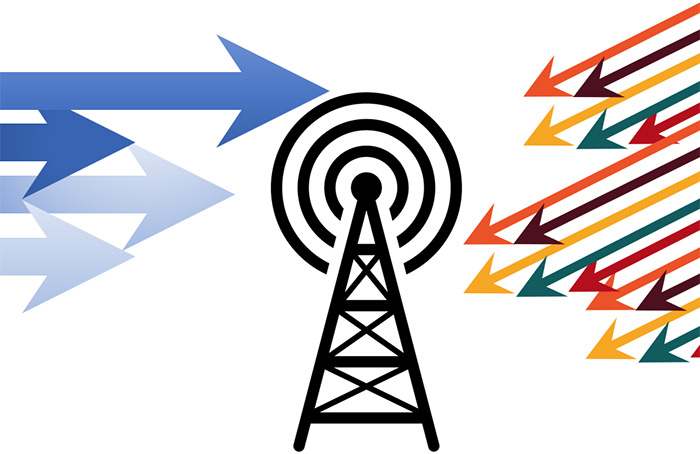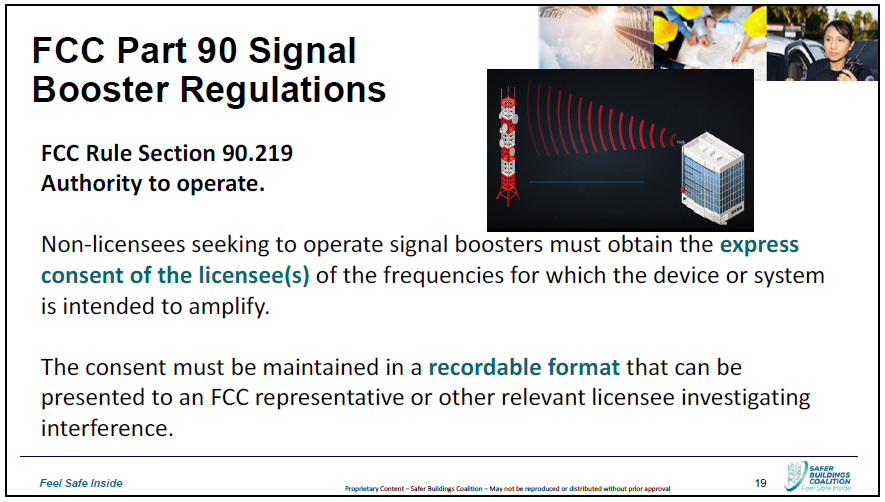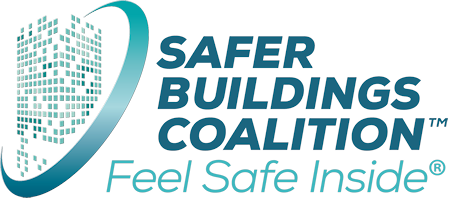In-Building Public Safety Coverage at the Crossroads of Conflict

Posted on March 4, 2021 “In the Middle of Difficulty Lies Opportunity“ - Albert Einstein
Safer Buildings Coalition has made a lot of “noise” about our No-Noise Task Force [see related article this issue].
But it may be that we’ve focused too much on the Task Force’s what and the how, but maybe not the why.
To put it succinctly, Radio System Operators / Administrators / Managers – i.e., the FCC License Holders, have had it up to here with the incidences of harmful noise and interference on their public safety radio networks caused by improperly deployed BDAs.
And they have begun to act. Recently, an FCC complaint was filed on a building owner out west as a result of an interfering BDA. Rumor has it that more violations are forthcoming. Battle lines are being drawn.
How Did it Get this Way?
As Fire Codes have evolved over the past 12 years, there has been strong emphasis on expanding and refining the fire codes and standards, and the role of the Fire Marshal or Fire Code Inspector. While references to the FCC rules have always been present in the codes and standards, perhaps there hasn’t been enough focus on the FCC License Holder who actually operates the radio system.
Consequently, the processes that have evolved are too often missing the critical coordination steps that ensure that one hand knows what the other is doing, that the best solutions are chosen, and that above all else, the FCC rules are followed.
A document is available online from the National Public Safety Telecommunications Council (NPSTC) that catalogues some examples of interference for Public Safety Radio Systems.
One famous Example in South Florida Follows.
Sunday, April 19, 2015 - Broward County Public Service Trunked Radio System (TRS) has been experiencing some major interference issues since last week (mainly the western portion of the County from north to south). It has been identified that 8CAL90 is also impacted, as well as areas in Miami-Dade. Palm Beach has advised that they are currently not affected. This interference is also affecting the SLERS users in Miami and Broward. The portable units are the most affected.
April 20, 2015 -Since Thursday, April 16, 2015 afternoon agencies on 800 MHz spectrum in the southeast have been experiencing interference.
Radio Systems Impacted by Interference:
Areas Impacted by Interference:
While continuing to send teams to try to determine the source of the interference, yesterday we discovered a substantial increase in the noise floor on our RX band radiating in the downtown area. While in a helicopter we were looking at a -70 dBm signal.
Based on the field units, it was determined that a 45-story building downtown (Biscayne Blvd NE 28 St) had a very high signal. The new building had five Bi-Directional Amplifiers (BDA) that were activated on Thursday 4/16. The senior project manager at the site agreed to turn off the equipment. This took place shortly before midnight.
Follow Up Note: 4/21/15 – The FCC field responders reviewed the 2 buildings we found BDAs installed causing the issues (one in the City of Miami on 4/19 and one in the City of Hallandale on 4/20). We arranged meetings for the FCC with staff and the BDA installer. The FCC is following up on the issue.
Sometimes, One Hand May Not Know What the Other Hand is Doing
Fire Marshals and Inspectors, relying on fire and building codes, are understandably confused about the controversy. After all, Fire Code is clear: Public Safety Radio Coverage is required inside buildings.
So, they should be able to enforce these codes, right? Not exactly.
Code officials can require that adequate coverage be present in a building, but not how that coverage should be achieved. That is the role of the FCC License Holder. In fact, by FCC rules, only the FCC License Holder can grant permission for third parties (like building owners) to operate signal boosters like BDAs.
There have been some critics who have made statements which might be paraphrased as “Fire Code officials and Fire Marshals have no business getting involved in the subject of public safety radio coverage. Only the FCC License Holders have any say in this matter. If everyone would just follow the rules, we’d have no problem.”
On some level, there is some merit to this thinking, as FCC rules do make it clear that the FCC License Holder is the ultimate authority when it comes to managing their licensed frequencies.
However, saying that Fire Code officials and Fire Marshals have no business getting involved in the subject of public safety radio coverage – or that the public safety agencies themselves have no stake (either operationally or financially) in whether their radios work inside buildings - is simply not the case. The FCC Says so!
The following excerpt is from the FCC Report and Order (WT Docket No. 10-4 ¶ 151) issued February 20, 2013:
151. We also seek to address concerns raised in the record regarding installation and operation of PLMR signal boosters by third parties, particularly for public safety uses. Signal booster systems play a crucial role in allowing public safety first responders to communicate in buildings, tunnels, and other areas where signals would normally be blocked. In many instances, however, these signal booster systems are not deployed or operated by licensees. Instead, they are installed by DAS professionals for building owners, often to comply with local building codes that require them to enable public safety communications. The Public Safety Licensees argue that by implication, Section 90.219 requires licensee consent for these “private placement[s]” of PLMR signal boosters. We conclude that this requirement should be made explicit and we amend Section 90.219 accordingly. We find that allowing third parties to operate signal boosters with express licensee consent serves the public interest by promoting reliable communications, particularly reliable public safety communications.
Our reading of this paragraph is that the FCC recognizes that:
SBC’s Response: Past, Present, and Future
Discussion within the membership of the Coalition on this subject began to rapidly escalate in early Spring of 2019.
While SBC training has always acknowledged FCC rules in our training materials, by 2019 SBC began to implement a much stronger focus on the FCC rules, License Holders, and correct design practices into our public education and industry speaking materials. Here are some highlights.
 Slide from SBC Training Deck – one of nine slides currently included in SBC training on FCC Rules
 Measuring Indoor Radio Coverage – Presentation by No Noise Task Force Steering Committee Member Michelle Geddes, Chief Information Officer – City & County of San Francisco Department of Emergency Management
What is Happening Right Now?
And the latest and most ambitious action has to do with the No Noise Task Force. To put it bluntly, together with all the relevant stakeholders, we intend to solve this problem.
Simply saying “If everyone just followed the rules we’d all be fine” ignores the fact that there are lots of Fire Code officials around the country working every day to enforce these codes. We can’t wish this problem away. We have to address it with all the stakeholders in the room, and this is exactly what the No Noise Task Force sets out to do. We intend to do this with the FCC License Holders sitting at the head of the table.
Not Just Fixing the Problems in the Rearview Mirror – But Setting Up the Future
A key example of this is the very substantial effort on the part of the SBC Codes and Standards Work Group, and our Executive Director Chief Alan Perdue, to make numerous changes to the upcoming NFPA and IFC codes and standards that highlight, emphasize, and make obvious and specific reference to the critical nature of following FCC rules and involving the FCC License Holder with regard to any in-building public safety radio coverage solution.
Just a few Examples of changes proposed for upcoming code editions:
NFPA 1225 Standards for Emergency Services Communications 18.12.2 RF-Emitting Devices.
18.2* Approval.
A.18.2 In most countries the Licensee is responsible for proper equipment operation and proper use of the frequencies to which the Licensee is licensed. Therefore, the Licensee must be able to review and approve every in-building emergency responder communications enhancement system design prior to any installation work being done. In the United States this is covered in FCC rules 47 CFR 90.219.
18.3.1.2.1 Inside the building or structure the maximum propagation delay shall be the standard provided by the AHJ and the Licensee.
18.3.1.3 The in-building technical solution employed shall not cause interference or degradation to the existing public safety radio communications system, or any other licensed radio system in the vicinity.
18.3.1.3.2.1 The owner of the in-building enhancement system shall repair said system within 5 business days of notification by the Licensee.
18.3.1.3.2.2 Upon satisfactory repair of the in-building enhancement system, the owner of said system shall apply in writing to the Licensee to request re-activating the system.
18.3.2.3 All RF Emitting Devices required for the in-building technical solution shall be certified by the Licensing Authority for use for public safety use on the frequencies used by the in-building technical solution before being installed.
18.3.4.1.2 To maintain proper alignment with the macro system
1.2 There are multiple system choices to solve the problem of in-building RF coverage for ERUs. The choice depends on many factors including proximity and numbers of buildings with such systems, the RF noise floor in the area, costs to agencies and building owners alike, and access by varying agencies such as fire, EMS, and law enforcement. Ideally the RF Design Professional should provide Licensees and AHJs with an analysis of the pros and cons of the choices most useful in the particular building, and the AHJ and Licensee can make the determination of which choice to pursue.
IFC
510.5.2 Approval prior to installation. Amplification systems capable of operating on frequencies licensed to any public safety agency by the FCC or other radio licensing authority shall not be installed without prior coordination and written approval of the fire code official and the frequency license holder(s).
Conclusion
We can do no less. Lives are at stake – we have to get this right, and we have to do better.
Building owners are caught in the middle here. Citing building owners with FCC violations may shake the leaves on the trees, but it doesn’t address the root problem – that we need to get everyone on the same page by:
This is exactly what the SBC No Noise Task Force was created to achieve. As Albert Einstein said: “In the Middle of Difficulty Lies Opportunity“.
|
